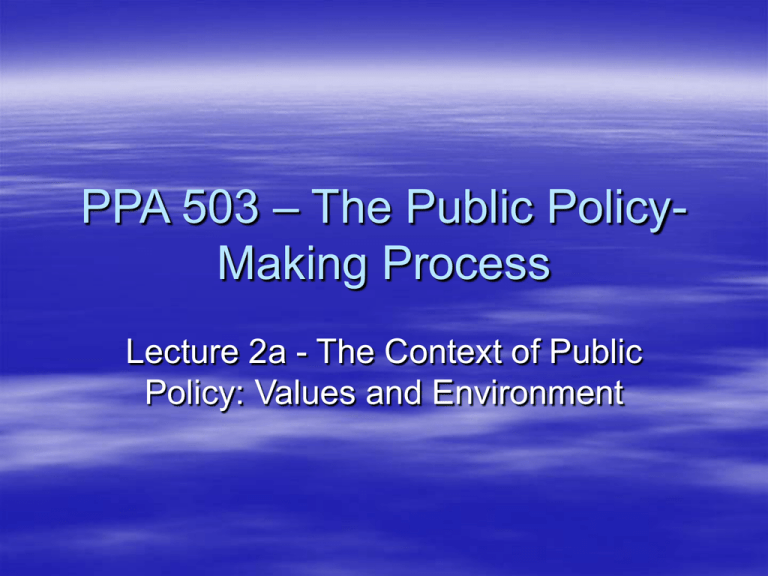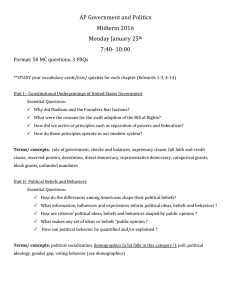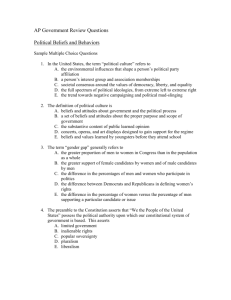PPA 503 – The Public Policy
advertisement

PPA 503 – The Public PolicyMaking Process Lecture 2a - The Context of Public Policy: Values and Environment Historical Development of Public Policy The history of American politics and policy is characterized by considerable change. The policy history of the United States is characterized by “policy restraint”. The history is divided into four eras: – A period of divided power, – An era of state activism, – An era of national activism, and – An era of national standards. Historical Development of Public Policy Divided power (1787-1870). – Weakness of national government under Articles of Confederation, Shays’ Rebellion. – The Constitution placed limits on scope of federal government, but was still much stronger than the government under the Articles. Also contained structural impediments to radical policy. Division of powers and separation of powers. Policy conflicts tend to turn on jurisdictional questions as much as policy questions. (Which level of government as important as what to do). Historical Development of Public Policy Divided Power (contd.) – Powers granted to Congress fell into two categories: management of national responsibilities (defense) and commercial responsibilities (interstate commerce). – Powers broadened by “necessary and proper” clause”. – In general, however, from the perspective of the average citizen, the federal government was not the most important official participant in policy making. – Reinforced by structure, Founder’s understanding, rural nature of the population, sparseness and homogeneity, libertarian political philosophy, absence of industrialization. – Embodied by conflict between Hamilton and Jefferson. History supported Hamilton. Historical Development of Public Policy State activism (1870 to 1933). – Industrialization and attendant increases in wealth, poverty, crime, disease. – Increased attempts at state regulation, but difficult for individual states. Interstate commerce suggested federal intervention, but federal government reluctant. Did pass Sherman Anti-Trust Act in 1890. Clayton Act 1914, Pure Food and Drug Act. Many trust breakups. (Now remerging). Federal government supported laissez-faire economics in its court and legislative decisions (Lochner vs. New York 1905). – Integration of former slaves into society 1865 to 1880s. Declined thereafter (Plessy vs. Ferguson 1896). Turned control of issue over to states. Historical Development of Public Policy National activism (1933-1961). – Demands triggered by Great Depression. – Lochner rule influenced Supreme Court actions on New Deal until 1937. – New Deal created modern system of national activism. Further enhanced by federal government activity during World War II. – National Defense system in 1950s. Historical Development of Public Policy National standards (1961 to 1981). – Great Society. – Scientific study of public policy impelled by federal government’s efforts to set standards for states and localities. – Retrenchment caused by Vietnam and Watergate restrictions on President. Budget and Impoundment Control Act. War Powers Act. Historical Development of Public Policy The end of big government? (1981-present). – The election of Ronald Reagan. – The Reagan Revolution changed the tenor of American politics and signaled a realignment. – These eras suggest that the American constitution without substantial change is flexible enough to bend, but not break in the face of major policy upheavals. Stability in American Politics and Policy Making Table 2.1. Elements of American Stability Type What this means Examples in action Ideological stability Americans tend not to stray from a set of ideological precepts based largely on our national experience. No labor party because of some suspicion of class warfare. Political stability Politics in the U.S. tends to be fairly stable for extended periods. Our constitutional structure has changed little. 27 amendments. Policy stability Policies tend to change very little over time. The gradual evolution of Social Security over sixty years. Stability in power Changes in power do not cause major policy, political, or social upheavals. The transition from one President or Congress to another is generally very smooth Source: Derived from James A. Anderson, Public Policymaking, 4th ed. Stability in American Politics and Policy Making Ideological stability means that Americans and their representatives have not been quick to shift their basic political beliefs. Since the founding and even before, Americans have believed in personal liberty and equality (except for those outside the mainstream), a generally limited government, “popular sovereignty”, the rule of law, and respect for market economics, private property, and free enterprise. – Although attitudes have changed on a multitude of issues including slavery, racial discrimination, the rights of women and children, and voting rights, the core values have remained the same. – The acceptable range for ideology is much narrower in the U.S. than in Europe. Reinforced by the single member district and the two-party system. – Some beliefs can be contradictory. Equality and capitalism, for example. Stability in American Politics and Policy Making Political stability is a key element of our overall national stability. We have operated under the same constitutional arrangement since 1789 (oldest continuously operating system with a written constitution). – Although many more groups have been included, the basic rules have remained the same. Structure that promotes a two-party system, Presidential election by electoral college, Senate based on state representation, House apportioned to population. Reinforced by stable beliefs. Stability in American Politics and Policy Making Policy stability – Political stability produces policy stability. – American government and constitutional system not designed to be quickly responsive to national needs or desires. Checks and balances, separation of powers New Deal conflict, and court packing plan example. Clinton’s health plan examples. – The federal system also operates to delay policy change. Laboratories of innovation versus status quo orientation. In many senses, the constitution a counterrevolutionary document. The Civil War may have been more revolutionary. Policy Restraint and Barriers to Change One should not conclude that policy stability is solely the result of the constitutional structure, or that policy change can happen. It is just very difficult. Barriers to change. – Ideological and political stability. Shared power, high barriers to amendment, separation of powers, checks and balances. – Basic rules and norms. The Senate filibuster Seniority Congressional procedural rules – Open government and policy restraint. Open public meeting laws, Administrative Procedure Act, and the Freedom of Information Act open up the process for public scrutiny and by side effect slow down the policy process. Policy Restraint and Barriers to Change A rationale for stability. – Deliberation and public participation are at least as important as rapid and efficient policymaking. – Rapid policy change can happen with the right combination of political factors, but during normal periods, minorities can block policy change and the system preserves their right to do so. – Policy does not change rapidly because most of the public does not support such change except under rare circumstances. Policy Restraint and Barriers to Change Fragmentation. – Fragmentation is a double-edge sword. On the one hand, it requires multiple serial majorities to promote change. On the other hand, it offers multiple points of access to the policy process. – Dimensions of fragmentation. Separation of powers. Division of powers (federalism). Policy Restraint and Barriers to Change Table 2.2. The Balance of Power Function Congress President Courts Legislative Make laws Recommend laws; veto laws; make regulations that have the force of law. Review laws to determine legislative intent, new interpretations Executive Override vetoes; legislative vetoes of regulations Enforce and implement laws. Review executive acts; restrain executive actions. Judicial Impeach judges and the president, call witnesses to hearings, set judicial jurisdiction. Pardon criminals, nominate judges Interpret laws. Note: The primary function of each branch is indicated in the boxes with the diagonal lines. Core Values and Beliefs in American System Fundamental Beliefs – Life The individual's right to life should be considered inviolable except in certain highly restricted and extreme circumstances, such as the use of deadly force to protect one's own or others' lives. Core Values and Beliefs in American System Fundamental Beliefs – Liberty The right to liberty is considered an unalterable aspect of the human condition. Central to this idea of liberty is the understanding that the political or personal obligations of parents or ancestors cannot be legitimately forced on people. The right to liberty includes personal freedom: the private realm in which the individual is free to act, to think and to believe, and which the government cannot legitimately invade; political freedom: the right to participate freely in the political process, choose and remove public officials, to be governed under a rule of law; the right to a free flow of information and ideas, open debate and right of assembly; and economic freedom: the right to acquire, use, transfer and dispose of private property without unreasonable governmental interference; the right to seek employment wherever one pleases; to change employment at will; and to engage in any lawful economic activity. Core Values and Beliefs in American System Fundamental Beliefs – The Pursuit of Happiness It is the right of citizens in the American constitutional democracy to attempt to attain--to "pursue"-happiness in their own way, so long as they do not infringe upon rights of others. – Common Good The public or common good requires that individual citizens have the commitment and motivation--that they accept their obligation--to promote the welfare of the community and to work together with other members for the greater benefit of all. Core Values and Beliefs in American System Fundamental Beliefs – Justice People should be treated fairly in the distribution of the benefits and burdens of society, the correction of wrongs and injuries, and in the gathering of information and making of decisions. – Diversity Variety in culture and ethnic background, race, lifestyle, and belief is not only permissible but desirable and beneficial in a pluralist society. Core Values and Beliefs in American System Fundamental Beliefs – Truth Citizens can legitimately demand that truth-telling as refraining from Iying and full disclosure by government be the rule, since trust in the veracity of government constitutes an essential element of the bond between governors and governed. – Popular Sovereignty The citizenry is collectively the sovereign of the state and holds ultimate authority over public officials and their policies. – Patriotism Virtuous citizens display a devotion to their country, including devotion to the fundamental values and principles upon which it depends. Core Values and Beliefs in American System Constitutional principles. – Rule of Law and Judicial Review Both government and the governed should be subject to the law. – Separation of Powers Legislative, executive, and judicial powers should be exercised by different institutions in order to maintain the limitations placed upon them. – Representative Government The republican form of government established under the Constitution is one in which citizens elect others to represent their interests. Core Values and Beliefs in American System Constitutional principles. – Checks and Balances The powers given to the different branches of government should be balanced, that is roughly equal, so that no branch can completely dominate the others. Branches of government are also given powers to check the power of other branches. – Individual Rights Fundamental to American constitutional democracy is the belief that individuals have certain basic rights that are not created by government but which government should protect. These are the right to life, liberty, economic freedom, and the "pursuit of happiness." It is the purpose of government to protect these rights, and it may not place unfair or unreasonable restraints on their exercise. Many of these rights are enumerated in the Bill of Rights. Core Values and Beliefs in American System Constitutional Principles – Limited Government The powers of government may not be used to restrict fundamental freedoms including life, liberty, and property. – Freedom of Religion There shall be full freedom of conscience for people of all faiths or none. Religious liberty is considered to be a natural inalienable right that must always be beyond the power of the state to confer or remove. Religious liberty includes the right to freely practice any religion or no religion without governmental coercion or control. Core Values and Beliefs in American System Constitutional Principles – Federalism Power is shared between two sets of governmental institutions, those of the states and those of the central or federal authorities, as stipulated by the Constitution. – Civilian Control of the Military Civilian authority should control the military in order to preserve constitutional government. Information Management in Public Policy The environment of public policy in the United States has changed dramatically because of the advances in information technology. In 1813, Congress made provision for the protection of state documents by requiring that copies of important legislative documents be made available to selected universities, state libraries, and historical societies. The origin of the federal depository library system. Information Management in Public Policy By 1945, the USGPO was doing eight mailings per day to each of 418 depository libraries. Beginning in 1980s and 1990s, the USGPO began the shift to microfiche. In the 2000s, the USGPO is not the only source of information and most documentation is now electronic. The Cold War: Origins of Information Technology in the U.S. Colossus computer – 1943. Codebreaker. ENIAC – 1942—1946. Ballistics calculations. UNIVAC 1 – weighed 8 tons. - Sold to Census Bureau. First commerical sale. – U.S. Navy and Atomic Energy Commission bought the next two. – First private sector purchaser – General Electric. The Cold War: Origins of Information Technology in the U.S. Mainframe computing – 1970s – IBM 370. – IBM 7090, first transistorized computer. Personal computer – 1980s – Apple – IBM PC – Ended the use of mainframe computing by government. The Cold War: Origins of Information Technology in the U.S. Advanced Research Projects Agency (ARPA) within Department of Defense. – Over 12 years, major governmental initiatives reconstructed telecommunications infrastructure and provided foundation for the Internet. – Data communications technology (air defense). – Communications satellite development. – ARPAnet 1969 – first cooperative computer network. Architecture of Federal Information Policy, 1946-1980 Administrative Procedures Act of 1946. – Federal Register, electronic 1993. Federal Records Act of 1950. – Preserve documentation of the organization, functions, policies, decisions, procedures, and transactions of agency. The Freedom of Information Act of 1966. – Right to public access to government information. Architecture of Federal Information Policy, 1946-1980 The Technology Assessment Act of 1972. – Office of Technology Assessment, later superseded by other technology agencies. The Federal Advisory Committee Act of 1972. – Timely notice in Federal Register of advisory committee meetings. The Privacy Act of 1974. – Protects privacy of individuals identified in information systems maintained by federal agencies. Architecture of Federal Information Policy, 1946-1980 The Government in the Sunshine Act of 1976. – Public entitled to fullest information on decision-making processes of federal agencies. Presidential Records Act of 1978. – Made presidential records public rather than private. The Paperwork Reduction Act of 1980. – Mandated an information resource management (IRM) approach to federal data. From BITNET to FIRSTGOV: Growth of the Internet 1981-2000 BITNET (1981) – Because It’s Time NETwork. – Cooperative network situated at CUNY. NSFNet (1986) – Managed with IBM, MCI, and Merit Network. 10,000 hosts by 1987. Combination of ARPANet, BITNET, and NSFNET provided infrastructure for the Internet. 1984 – Domain Name System (DNS) and Uniform Resource Locators (URL). From BITNET to FIRSTGOV: Growth of the Internet 1981-2000 Internet Corporation for Assigned Names and Numbers responsible for civilian URLs, FTP, lookup files. Military responsible for .mil, Feds responsible for .gov, and foreign countries for the suffixes. In 1992, federal government repealed acceptable use policy allowing commercialization of the Internet. 1992 – Supreme Court prohibited Internet sales taxation for companies without physical presence in state. 1993 – Federal funding of internet ends. 1995 – Concept of the “Digital Divide.” 2000 – FirstGov.gov, portal to all government information. Policy Issues in the Information Age, 1986-2005 Public access to information. Public participation in e-government, including public comments on federal regulations. Accessibility for disabled. Rehabilitation Act Amendments of 1986. Individual privacy. Matching regulated but more match since 9/11. Policy Issues in the Information Age, 1986-2005 Modernizing education. Increased technology infrastructure. Regulating e-vice. – Child Online Protection Act of 1998 (unconstitutional). – Child Pornography Prevention Act of 1996 (unconstitutional). – Prosecutorial Remedies and Tools Against the Exploitation of Children Today Act of 2003 (PROTECT). – Child Obscenity and Pornography Prevention Act of 2003 – Many more acts. Policy Issues in the Information Age, 1986-2005 Securing intellectual property. – Digital Millennium Copyright Act of 1998, extended to digital media. Fair use for universities. Prohibited removal of copyright management information from digital media. Electronic voting. – Shift from paper ballots, but many security issues. Regulating the outsourcing of IT jobs. – Raises information security issues. Securing E-Government, 1986 2005 Guaranteeing security of cyberspace key issue. 1980s mostly computer crime. 1990s, architecture for securing cyberspace against foreign and domestic enemies. Presidential Decision Directive 63 (Protecting America’s Critical Infrastructure). Government Information and Security Reform Act of 2000. 9/11. Securing E-Government, 1986 2005 USA Patriot Act of 2001. Cyber Security and Research Act of 2002. Amendments to Fair Credit Reporting Act to reduce identity theft. OMB – Information Systems Council to coordinate sharing of terrorist information. 9/11 Commission – separate, secure network for federal information sharing.






